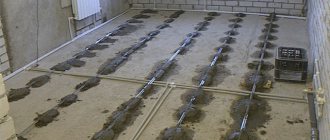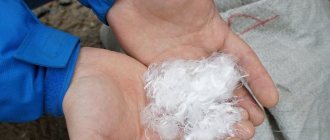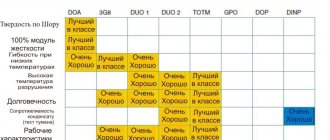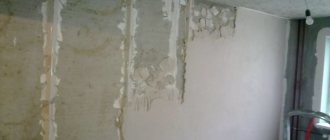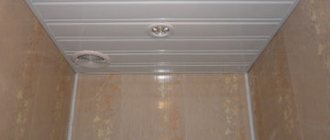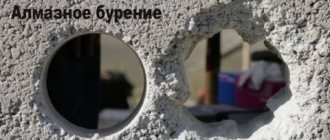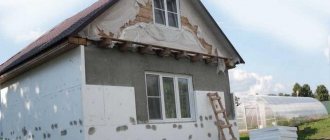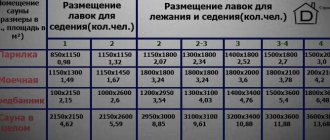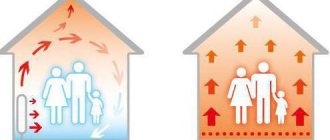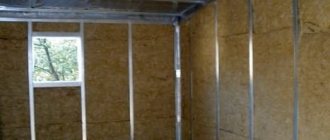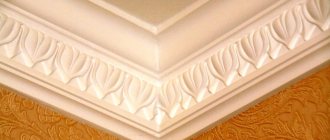Home |Construction |How to place beacons under a floor screed?
Date: August 28, 2017
Comments: 0
The technology for installing any type of floor covering requires the elimination of defects and unevenness, followed by planning and ensuring the horizontal surface of the floor. In order to level the base, a dry or wet cement-based composition is used, which is distributed evenly over the surface. Beacons for floor screeding are used when performing this operation, serving as a guide, as well as simplifying the process of pouring the base and facilitating the work. Let's dwell on the varieties, figure out how to install beacons for screeds, study the specifics of installation, as well as the technology of implementation.
What are floor screed guides?
Beacons are special elements fixed at one mark, located horizontally and at an equal distance. Varying in design, guides provide a solid base, the top level of which serves as a guide when forming the base.
Beacons are simple devices intended for one-time use.
The location and correct installation of the fixed elements determines the level of the future floor, affects the final appearance of the decorative coating, as well as its characteristics during operation. The method of making the screed is influenced by the design features of the guides and the materials used in manufacturing.
The following types of special elements are in demand:
- rack and pinion
They are used when forming a dry base with expanded clay filler, as well as when arranging a sand-cement or concrete base using the wet method; - rappers.
Used in the manufacture of self-leveling bases. They are a structure with a height-adjustable rod fixed to a base with three support points.
Beacons for self-leveling mixtures
Some people consider the level control procedure unnecessary. They are confident that a screed without beacons significantly saves time, especially when it comes to work using self-leveling mixtures (for example, self-leveling floors). But this opinion is not entirely correct: firstly, the beacon-benchmark, which is used in this case, has a simple design; and secondly, it does not require much time to install and dismantle it. Setting beacons for this type of screed is simple, but they allow you to adjust the thickness of the fill. We proceed like this:
- prime the surface;
- let it dry for 4-5 hours;
- set benchmarks (step – 1 meter);
- by rotating the control rod located in the center, we set the height of the beacon, which corresponds to the previously made markings;
- pour the mixture;
- level;
- dismantling the benchmarks.
Varieties of elements and recommendations on how to install screed beacons
When carrying out activities to form floor foundations, the following types of elements are used as guidelines, differing in the material used and design features:
- Wooden slats.
The control level is formed by square wooden blocks with a side of 3 cm. The vertical displacement is adjusted by placing conical wedges of different thicknesses under the bars. It is allowed to use self-tapping screws of increased length. Pre-soaking wooden beams in water reduces moisture absorption when using the wet pouring method. The main disadvantage is the possible warping of the wood, as well as the need to remove the bars from the formed massif. This way the wood can be prevented from decomposing over time.
Beacons for floor screed are divided into groups depending on the type of mortar being poured
- Metal profiles.
The most common type of device today. U-shaped profiles with dimensions of 2.7x2.8 cm and 2.7x6 cm are used. They are fixed with self-tapping screws to the base with the flat side, and the sharp edges of the U-shaped structure are located in the opposite direction. In order to increase the strength characteristics, the installation of nested profiles is used. The design has proven itself positively when performing activities in rooms with limited space. The height of the profiles is adjusted by rotating the threaded rods. - Plaster profiles.
They are used as guide rails when carrying out plastering activities and forming floor foundations. Their use when performing finishing work significantly facilitates the process of leveling the base and shortens the overall production cycle. The slats are attached to the base using cement mortar. A profile with a height of 0.6 cm is used for plastering activities. Surface planning is carried out using beacons with a side size of 1 cm. Increasing the layer thickness to three centimeters can bend the profile, which is deformed under the weight of the heavy solution. - Benchmarks.
The zero mark is determined by the location of the rod, the degree of vertical movement of which is adjustable. It is secured in a support structure supported by three points. When performing work, benchmarks are placed at intervals of up to one meter in a checkerboard pattern. Using several reference points allows you to plan the floor in one room. Benchmarks are widely used by professional builders who have special training and know the features of their installation. After the filling process is completed, the control elements are easily removed from the formed array.
Installing beacons using self-tapping screws is also popular
- Self-tapping beacons.
Self-tapping screws or self-tapping screws screwed into the base are the basis for performing work on forming the surface. Threaded winding facilitates screwing at the required level for subsequent tension of the construction thread between them. Cement mortar is then laid in slides along the cord to install the guides. The installed profiles rest on the formed slide and are immersed in cement mortar to the required level so that the supporting surface touches the cord stretched between the screws. The interval between the screws located in opposite rows should allow the rule to be used with a margin of 5–7 cm in each direction. - Metal pipes.
The use of steel pipes makes it possible to fill floors of increased thickness in rooms with larger dimensions. The design features of the tubular elements are increased strength characteristics and the complete absence of deformation under the influence of the mass of the cement base. The use of round pipes as guide supports, as well as box-shaped structures of square or rectangular cross-section, allows you to form a reliable base that maintains its position when filling the interval between the elements with cement mortar. - Guides from the solution.
A supporting surface made of cement mortar is used when laying out floors using the dry method, with the composition being laid in an increased layer. Cement mortar slides are made starting from the corner areas of the room along its length, with an interval between the supporting surfaces corresponding to the length of the base leveling tool. In accordance with the location of the zero mark, the height of the cement platform is formed. The process of screeding is carried out using a rule that moves along the surface of concrete slides after their final hardening.
There is another unusual way to set horizontal landmarks - cement slides
After reading the recommendations, it’s easy to figure out how to set up beacons for floor screeds, depending on their types.
General practical advice
Despite the existence of a large number of methods for installing beacons under floor screed, professional builders have developed general tips for all cases.
Tip #1
Before starting work, it is recommended to check the condition of the base using an ordinary lath or a long rule. Apply the tool along the diagonals of the room, then at several points around the perimeter. As a rule, install a long bubble level; with its help, try to hold the tool in a horizontal position and measure the gap between it and the plane of the base. The purpose of the preliminary inspection is to detect the area of the floor with the maximum protrusion. If it is small in area, then it is much more effective to cut off the protrusion with a hammer drill than to increase the thickness of the screed by several centimeters. This not only speeds up the work process, but also reduces the estimated cost of floor installation.
Bubble level for construction
Tip #2
If you don’t have a laser device, you can set the level of the beacons using an old water level. By the way, this is the most accurate instrument in nature. No modern laser can compare with water in these indicators. A water level is an ordinary flexible transparent hose filled with water; it can be painted in different colors to improve visibility. The water level works according to the fundamental law of physics - the law of connected vessels. This means that the liquid level in such vessels will always be the same; it is leveled by gravity.
Water level
You need to make marks using this level in the following sequence. You need to work with an assistant; you cannot complete the markings alone.
- Place a mark on the wall at a distance of about a meter from the floor, the specific height does not matter.
- Place one end of the water level to this mark, the other end should be located against the opposite wall. Achieve a position so that the water level on the wall coincides with the zero mark on the hose; in this state, make a mark for the location of the water level at the second end of the hose. Both lines will be strictly horizontal.
- Using the same pattern, make marks around the entire perimeter of the room and connect them with lines using upholstery rope.
- Now you have a horizon throughout the room, use it when placing beacons.
How to use a water level
At first glance, it seems that working with a water level is much more difficult than working with a laser level. This is not true, it all depends on the practical skills of the performers. Of course, a laser device has many significant advantages; you need to know them and use them in practice. But the ability to use traditional measuring instruments will always be useful in life.
Tip #3
There is a method for installing beacons on a line made of cement-sand mortar. In essence, it is not much different from those described above, only under the metal profiles, not individual buns are made, but continuous tubercles of the appropriate height. Professionals try to use this method whenever possible. Its disadvantages are fully compensated by its advantages.
Lighthouses are installed on a line made of cement-sand mortar
There are two disadvantages: an increased amount of solution is required to install beacons and its preparation requires additional time. But when laying the screed, significant time savings are achieved. The fact is that it is necessary to push a mass under the freely sagging beacon profiles; this takes a relatively long time and is very inconvenient. If the beacons have a solid base, then there is no need to push anything anywhere; the screed is made faster and easier.
Tip #4
The accuracy of the beacons depends on the parameters of the finishing coatings. If the screed for joists may have deviations of up to 1–2 centimeters in the corners of the room, then for linoleum the tolerance range is reduced to several millimeters. Keep this in mind and, in accordance with technological requirements, adjust the screed tolerances. There is no point in wasting time on excessive screed precision if the quality of the floor finish does not depend on it.
The accuracy of the beacons depends on the parameters of the finishing coatings
Tip #5
Never rush, the time required to re-check the position of the beacons is always much less than the time required to redo the tie. There is no need to talk about the price of the work. If you have absolutely no experience in performing this type of work, then it is better to practice in utility or technical rooms, and only then work on living rooms.
Beacons for screeds are checked
Definition of zero level
The process of determining the zero mark is one of the most critical operations affecting the quality of foundation formation. In order to determine the zero level, it is advisable to use a hydraulic level or use a modern laser device, which allows you to quickly and efficiently perform the work.
Installation of beacons for floor screed begins with calculating the zero floor level
Follow the following algorithm:
- Mark the starting point, moving one meter vertically up from the level of the floor slab.
- Using a level, draw a basic line along the closed contour of the room in which the work is being carried out.
- Check the distance from the drawn line to the floor surface and mark the farthest and closest point.
- Draw a line along the furthest point and connect the marks with a solid line, forming a base level.
- Move a meter towards the base and draw a solid line around the perimeter of the room, parallel to the existing mark.
- Step back from the resulting zero mark to the required height of 3–4 cm and draw a line.
The indicated line corresponds to the required thickness of the array and serves as a guide when performing work.
Types of screeds
You can properly level the floor using wet, dry or combined screeds.
Wet floor screed can only be done efficiently if there is a solid concrete base. Otherwise, a rough, preparatory screed is required.
There are four types of screed:
- knitted - used when leveling the floor in an apartment along the surface of floor slabs;
- with waterproofing - the screed layer is formed on top of the installed waterproofing layer;
- with thermal insulation - the formation of a screed layer over the laid thermal insulation layer;
- with a final self-leveling coating - the formation of a flat surface on top of the main screed using a thin layer of self-leveling liquid mortar.
Selecting the distance between beacons
Guided by the dimensions of the rule used to perform the work, it is easy to determine the interval between the supporting elements. During operation, the rule must slide along the supporting surface.
To do this it is necessary to provide:
- the interval between supports, which should be 10–20 cm less than the length of the tool;
- parallel arrangement of guides and equal distance between them.
You need to start installing the rail from the wall. The distance will be approximately 10-30 cm
The use of easily deformable materials as guides requires reducing the distance between them to 20–25 cm.
What methods of installing beacons are there?
There are several types of beacons, depending on the type of screed. It can be dry, semi-dry, wet or based on a self-leveling floor. Let's try to analyze all the options in more detail.
Features of dry floor screed and beacons for it
Dry screed is based on various building materials such as expanded clay, crushed stone, sand. In this case, the ideal option for arranging lighthouses would be to use a metal profile. However, it is worth understanding that the rise of the floor will depend on its height. In addition, if you install such beacons, you should choose a profile with rigid edges so that it does not sag later. If you plan to lay a soft floor covering later, it is better to choose a round or square pipe or channel instead of a soft profile. Naturally, such material will cost more, but reliability should come first.
For dry screed, various bulk building materials are used PHOTO: dekoriko.ru
Beacons here are installed at a height equal to the edge of the channel or profile from the zero level. Installation of such beacons is quite simple. Most often, a U-shaped profile is used, which is laid on a plane with the edges up and leveled. After this, expanded clay or other bulk material is poured on top (filling the space between the ribs and channels), which is leveled using the rule. The distance between the profiles should not exceed the length of the tool used for leveling.
Expanded clay is most often used as a dry screedPHOTO: zoompost.ru
Related article:
Semi-dry, wet screed and its varieties
This screed is performed using various solutions or mixtures. For her, installing beacons is a little more difficult. If the thickness of the planned screed is small, then you can use special beacons, leveling them and fixing them on plaster or alabaster, which dry very quickly. But sometimes a thick screed is needed. And here it is better to use a metal profile and special concrete screws, called dowels. Let's try to figure out these adjustable beacons step by step.
Pins are special self-tapping screws for concrete PHOTO: fasteners-kazan.rf
How to set beacons for floor screed at zero level
Setting to the zero level is carried out in accordance with the preliminary markings made, taking into account the thickness of the array. The supporting elements are fixed in such a way that the upper plane, which will be in contact with the rule, corresponds to the zero mark.
Sequence of events:
- Fix the first profile at a distance of 30–50 cm from the wall.
- Fasten the next element in parallel, taking into account the length of the rule.
- Check that the location of the guides corresponds to the zero mark.
Depending on the design of the beacons used, use the appropriate fastening method and the necessary elements for fixation.
It is important to ensure:
- fixed distance between supports;
- immobility of guides.
Preparatory work
Regardless of the type of beacons being installed, it is necessary to carry out a set of preparatory work. The surface is thoroughly cleaned of debris and remnants of the previous finishing coat; all wooden structures, including baseboards, are removed.
Dust and all types of dirt are removed; if there are any unevenness, they are sanded manually or with a grinder. The result should be a smooth horizontal floor surface.
All cracks and small recesses are carefully sealed with compounds with minimal shrinkage, time is allowed for them to set, and if necessary, re-grinding is done.
The prepared floor is covered with a protective primer and waterproofing; this will prevent the ingress of excess moisture and strengthen the structure.
Directly to install the beacons, it is necessary to determine the zero mark, which is done using a water or laser level. At a height of 1 m, a mark is placed on any of the walls. Next, at the same level, marks are made on the remaining walls and connected by a base line. The points are lowered 1 m down and connected by a line to obtain the zero level. If the floor is uneven, find the highest point and count the zero level from it. To set the thickness, a distance equal to the smallest thickness of the mortar layer is retreated from the highest point, and another line is drawn. Beacons are installed along it, and unevenness is leveled when pouring the screed.
How to make a floor screed using beacons
Using the example of a cement-sand composition, we will consider how to make a high-quality fill.
Carry out the work following the sequence of operations:
- Prepare a cement-sand mortar based on Portland cement grade M400.
- Gradually fill the space between the supports with mortar, starting from the far corner.
- Distribute the composition evenly as a rule, smoothly moving it along the supports.
- Move excess grout towards the area to be poured.
- Remove the floor screed guides and fill the existing recesses.
- Smooth out uneven surfaces using a wide spatula.
- Allow the cement mass to harden to ensure strength.
- Cover the surface of the screed with plastic wrap.
The normal course of the cement hydration process is facilitated by light and periodic moistening of the surface for two weeks.
Peculiarities
In order for the floor finish to look flawless, without wrinkles, cracks and unevenness, it is necessary to first level its surface. Most often, a screed is used for this - a special mixture that is evenly distributed over the entire surface of the room. It is difficult to visually bring even a few square meters under one level, so you have to install special rigid guides - beacons.
Placing beacons is only necessary in some cases; for example, when using a self-leveling floor, they are not needed, since the mixture itself, which has leveling properties, spreads evenly over the entire surface. But for concrete and cement-sand screeds, their presence is simply necessary. The minimum layer thickness for such solutions is 3 cm, and at the lowest points it can be more than 10 cm, so you have to use beacons.
Metal beacons look like hollow pipes, profiles or corners. They can be attached to cement mortar, gypsum plaster or self-tapping screws. Some make them from strong and smooth wooden beams or from the same mortar. The main condition is to maintain an ideal horizontal level on the entire surface of the floor in the room. After the beacons are installed and firmly fixed, they begin to pour the screed.
